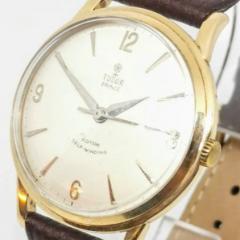Leaderboard
Popular Content
Showing content with the highest reputation on 01/11/18 in all areas
-
Thanks for all the help. I went for the eBay 7s36 rotor. The seller is confident it will work. mousekar, I'll keep you in mind if I need any other parts.2 points
-
2 points
-
Re-bushing should take place if it stopes the clock or is causing wear on other parts. The fly can be quite loose in the pivot hole and will work fine. The only time this might need re-bushing is when running it does not mesh with the next wheel, has it caused wear to the tops of the teeth does it skip a tooth, if the answer is no leave it. Just make sure the pinions are not worn to the extent that a new pinion is needed. You are not restoring this movement so if the bushing is fine I would leave things alone. It is most important that the escape wheel is correct any wear in depth will cause the pallets to escape wrong and the pendulum not to swing as it should. Escape wheels do take the brunt of the weight also in this case the brass bushing might not have been good quality brass. Some of the very early clocks are made of extremely hard brass and when it comes to reaming it out it just splinters away and takes ages to do. Check the pallet faces they should show signs of very little wear or no wear at all as steel is much harder than brass. If they shows signs of wear, they might need to be re- faced. I can help you with this if needed. Chinoiserie pagoda top hood not caddy top as there are decorations on the top, caddy tops were plain. The style of the hands are correct, so original, arched dial with silvered chapter ring andseconds, dial spandrels as expected, so original dial. Early 8 day dials had decorative rings round the winding holes, these were left off from C.1750 onwards. Round screw heads appeared after 1740 so any round screws in this movement might not be original, if the treads are crude then they are. The style of the trunk door tells me this was made after 1730 before this date doors were fitted so sa to be inside the case, this has its door fitted against the case and is quite wide. The movement is fixed to what is called a seat board. One thing I’m not happy with is the case is out of proportion, so just looking at pictures it looks as if it might have been cut down. What is the height, are there any marks inside that show rubbing of weights or pendulum marks. Did it work for 8 days or is it a month duration. The calendar hand is missing; it has a square fitting and would just be a plain pointer. That is an excellent site. I get some of my info from it as I can’t remember it all. I can’t remember what I did last week.2 points
-
Just saw this mentioned on a TheWatches.TV video on YouTube. Some really great deconstructions with really good photography. https://www.thenakedwatchmaker.com/ And here's the video teardown I watched.1 point
-
The escape wheel might well be a problem as you say see how it runs. I made a big mistake a few years ago with a escape wheel like yours. I straightened the teeth as best as I could then trying to be cleaver I run it on my lathe running a burnisher over the teeth to get them all exactly the same height. Result it would not run, I had removed too much material. B*gger or words to that effect were said.1 point
-
They all fit, including 7S, 4R, 6R and their SII equivalents. For details about 7S26 parts compatibility across versions check my table at: https://docs.google.com/spreadsheets/d/e/2PACX-1vRN2UULQKTfKmhRStZhDdIOIQrqd6sPB-g6x2SKyQQjOvTBjG_7TQXQhAT4f1WqAX5QAPkIimi-3jqd/pubhtml1 point
-
and so it is, would have never have found that otherwise, thanks.1 point
-
I'm from Skåne. It does seem like more and more Swedes are getting into the watch hobby, in one form or another.1 point
-
1 point
-
Välkommen landsman . Great to see some fellow Swedes here. What part of Sweden? I am from Småland.1 point
-
Go to 40:30 to see the lubrication of the escapement as described by Tiktok. The whole video is pretty useful though! The person who posted it, “perplxr” has a lot of very useful videos from watch maker schools and worth checking out. I’ve attempted to lubricate the escapement this way and can say it’ll take some practice. I was also not aware of the fixodrop trick. So I may try it again knowing this. Sent from my iPhone using Tapatalk1 point
-
This is the best clock oil; it is the one I used. It is suitable for all clocks. The dial doesn't need re-silvering it looks fine, If you undertake re-silvering it will look odd and the rest of the dial will need to be restored, that will mean polishing all the brass parts and lacquering. The dial is perfectly readable so leave it alone. This Longcase clock would have been very expensive when bought and it is worth a few thousand pounds today. https://www.cousinsuk.com/product/windles-clock-oil1 point
-
Thanks for the ad. I have an old Seiko quartz diver that needs attention, a new Hamilton Khaki Quartz and a Borealis Seafarer II. I like doing my own work on cars, motorcycles so I'm hoping to learn something here.1 point
-
There is no video that I am aware of but easy enough to practice from my explanation.1 point
-
I have in the past always oiled the pallets the traditional way, oiling the pallet face with a bit of power on the train and skipping through a few teeth and repeating it until the desired amount is applied. I also use fixodrop(epilame) on all of the escape wheel and also on the pallet entry and exit jewels(not on the pallet pivots or fork). Without a doubt fixodrop will make your oiling alot neater and tidier. Some of the Swiss brands are teaching a different method in house and encouraging you to oil the escape wheel teeth rather than the pallets. This method I have found once practised gives a lot more control on the amount of oil applied and makes a very neat job putting oil evenly on every tooth and giving a perfect stripe of oil across the pallet face where the escape wheel teeth slide across and not getting any oil riding on the top and bottom of the pallet jewels. This method is done by using fixodrop as usual and the putting the pallets and balance in, wind up the watch and let it run. On most Watch's there is a hole to inspect the escapement from the dial side, whilst the watch is running you can touch the oiler on the escape wheel teeth as it turns letting the escape wheel teeth pull the oil off the oiler, only use a small amount of oil and build it up with small amounts, you don't want the first tooth you touch pulling a big blob of oil off and it running down the tooth. The idea is to just have a small amount of oil on the edge of each tooth which will in turn deposit it on the pallet jewels exactly where it needs to be. Some calibres are easier than others for this method depending on access to the pallet jewels to get the oiler in from the dial side whilst it's running. Be careful not to put the oiler in too far and miss the escape wheel teeth or you will touch the bottom of the balance wheel and get oil on it.1 point
-
I see it is a five-pillar movement with inside count wheel strike. Try to get all the old line out from inside the barrels that will give you an indication how many times the lines have been changed. The pillars design tells me this movement is from the period 1660 to often used by London makers, and good provincial clockmakers. 1740 give or take a few years, if its from provincial makers as it took time for them to catch up with London. You find punch holes and marks on old clocks, this would have been carried out by a blacksmith, in many places back in those days villages never had watch or clock repairers but always a blacksmith, they would punch around the holes to close them, very unsightly but part of the history of the clock. All pivots should be straight without any marks. Double bushing usually means poor repairs and the person never had the right size and no lathe to make them. I would like to see the dial front and back, hands and case of this clock if possible.1 point
-
Generally speaking on most(if not all) eta calibres if the balance endstones are different sizes it is normally the balance cock that is larger than the main plate side, but as already said always make a mental note or write it down, even draw a picture if need be so you don't get them mixed up. The only reason I can think for them making the jewels different sizes is maybe cost, putting the bigger jewel on show from the case back side and hiding the smaller jewel setting under the dial.1 point
-
Plus 1 on the finger in a cot method, works for me although I'm sure others will have other thoughts. Sent from my Moto G (4) using Tapatalk1 point
-
I either hold in in place with my (covered) finger, or if I'm struggling with that, stick it in place with some rodico until I get the thread started.1 point
-
1 point
-
The best advice I can give you. When taking apart anything with end stones always make sure you do not mix them up as some can be different in many ways.1 point








